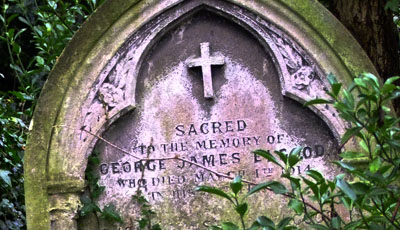24. Barely Legible Gravestone II – Here is another trick for reading worn gravestones. Modern digital cameras can now pick up a broader range of contrast than the human eye. You can use this to your advantage. Reading a worn gravestone is all about reading differences in contrast on the surface of the gravestone. Engraved letters will appear slightly darker than the rest of the surface because depressions on the surface tend to grab the light. To capture these differences in contrast, try taking a close-up photograph of the front of the gravestone on a sunny day. It is best to do this when the natural light is shining on the front of the gravestone at a shallow angle.
Don’t worry at this point if you can’t read anything on the gravestone. The whole purpose of this exercise is to see if your digital camera picked up something that your eyes missed. When you get home, run the digital image through photo processing software. Focus on progressively increasing the contrast of the image until the lettering starts to stand out. All photo processing software have a contrast function, it is part of the basic repertoire of a photographer. And don’t worry if you don’t own any digital photo processing software, there are several online versions you can use for free. For example, Google’s Picasa is a popular choice. It can be amazing how changing the contrast on a digital photo of a gravestone can make the inscription stand out, even on a worn gravestone.

To further improve your chances of success, there are a couple of additional manoeuvres you can do with this approach. First, try taking the photograph in the first hour of sunlight in the morning or the last hour of sunlight in the evening. This is what professional photographers do to get the most natural contrast in an image. Second, try to avoid cloudy days if possible. Natural light is diffused on cloudy days and you want strong contrasting light, not soft diffuse light. Finally, if you are really keen you can combine this trick with the one above where you used artificial light to try to read the gravestone. Strong artificial light at a shallow angle and a decent digital camera (turn the flash off) can make even really worn inscriptions pop out once you increase the image at home with digital photo processing software.
If you are not convinced that this approach will work, then you should know this is what archaeologists use to read worn ancient inscriptions. Of course, they have fancier cameras and use more sophisticated light sources, but the concept is the same. You can reproduce much of the technique yourself with a basic digital camera and a decent light source. We recommend this approach over taking a rubbing of a tombstone, which is time consuming and can both mark and damage the tombstone.

